The Avery Quadruple Needle Case Known as “The Lady Mayoress of London”
The following narrative was original written in the summer of 2020 and was published in the Thimble Collectors International Bulletin Fall 2020 issue. Two additional photos have been added that were not published in the article.
__________________________________________________________________________________________________________________________________I decided to write this article the day after I received the Summer 2020 TCI Bulletin, which asked members to write an article about their most recent purchase. The bulletin arrived while I was researching G. H. Johnstone & Co. and 18 other Birmingham, UK companies for a book I am writing. As a result, I thought this was the perfect time to tell others about my newest Avery needle case.
This year I was able to add one of the most interesting and unique items to my collection. I first saw it for sale at an action in the UK in 2014, but unfortunately my bid was not high enough. I thought I would never see it again. Surely, I assumed, it had been purchased by a museum as it was truly one of a kind. Then to my surprise it reappeared at an auction in March 2020. For me, having this item would be one of the highlights of my collection, so I placed a very large bid and was I ever delighted when I won it. Unfortunately, because of the Covid-19 pandemic and the needle case’s value, it spent many weeks in US Customs until I could prove it was over 100 years old and therefore not subject to additional import fees. At the time, I thought it would never arrive, but finally it did (Fig.1).
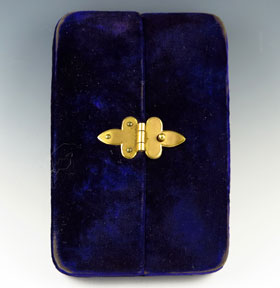
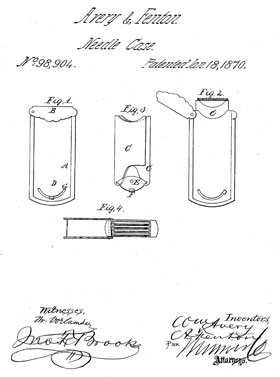
Left: Figure 1. My recent purchase. Right: Figure 2. Copy of U.S. Patent.
Now what Avery needle case could be that exciting? I’ve been collecting Averys since 1992, have been researching them since 2009 and published my first book about them in 2012. I also spent considerable time at The National Archives in Kew, UK and at the British Library in London researching these needle case patents, but until I saw this one in 2014, I never knew it existed. In 1868 William Avery, a needle manufacturer from Redditch, UK, registered the patent for a needle case design, one of his first, which became known as the Quadruple (Fig. 2). Two years later in 1870 the patent was registered in the USA. The Quadruple is a small rectangular shaped brass needle case, about 2.75 by 1.5 inches, with four slots inside where needle packets are stored. On the outside, in addition to a stamped design in the center, there are two numbers near the bottom separated by a small knob, described as a thumb bit in the patent, that allows you to move it from one side to the other. The numbers, usually 6 and 7 on one side and 8 and 9 on the other, represent the size of the needles in the corresponding interior packets. All you have to do to retrieve the needles you want is to open the top and slide the small knob to the correct size, then the packet for that size is pushed up for easy access.
Avery’s Quadruple needle case can be found with 20 slightly different exterior decorations and it is Avery’s most popular needle case design. It also can be found with 31 different company names, many from the London area. At first Avery licensed this design to other needle manufacturers in the Redditch area, perhaps hoping to profit by selling needle cases in addition to needles. However, once his competitors had their names stamped on Avery’s beautiful design, surely, they placed their own needles inside. As a small needle manufacturer, Avery needed a way to reach a broader audience so he could compete with his larger rivals, therefore around 1872 he stopped this practice. Licensing this needle case to large organizations such as drapers, warehousemen, wholesalers and the like, in places like London and New York, businesses with a broad market who were not competitors, was a win-win for both parties. The licensees were able to place their names on a beautiful item so their customers would remember them, and Avery was able to fill them with his needles, the result being increased sales of Avery needles. In a way these licensees were actually selling Avery’s needles for him.
Now let’s take a closer look at my newly acquired needle case known as The Lady Mayoress of London. Although the basic mechanical design of this needle case is exactly like Avery’s Quadruple patent, it has many unique features: 1) it is hallmarked and made of 9 carat gold, 2) it contains the name of the person for whom it was made, 3) the exterior is covered with beautiful hand engraved designs, and 4) it has a special elaborate box in which it is displayed.
This needle case is one of only four Averys I have ever seen with a hallmark (Fig.3). Most Avery style needle cases have the patent or design registration diamond mark on them which some people confuse with hallmarks, but actual hallmarks are quite different. During the Victorian period in the UK, most items made of silver or gold had to have a hallmark stamped on them. These hallmarks usually consisted of four parts: 1) the Standard Mark to indicate the purity of the metal, 2) the City Mark to indicate where the item was made, 3) the Date Letter to indicate when it was made and 4) the Maker’s Mark to indicate who made it. The hallmark on The Lady Mayoress of London consists of the numbers 9 375 followed by an anchor and then the letter X. Directly above these marks is a small shield with the letter G placed over the letter J. When translated these mean the needle case was made of 9 carat gold, was registered in Birmingham and was made in 1897 by G. H. Johnstone & Co. (Fig.4). To the best of my knowledge, this is the only Avery style needle case ever made in gold. Although there were five other Quadruple needle cases made in silver, all of the other Avery style needle cases were made of brass, which was usually gilded to give the appearance of gold, or they were made of nickel-silver or plated with nickel-silver. Nickel-silver is a metal created to give the appearance of silver but is much less expensive because it is an alloy of copper, nickel and zinc.
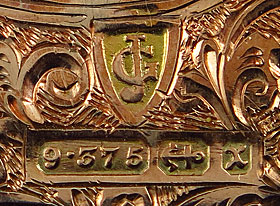
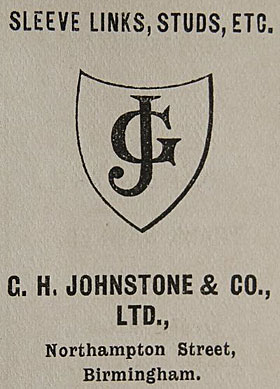
Left: Figure 3. Hallmark. Right: Figure 4. Johnstone trademark.
Only four Avery needle cases were made for specific individuals. How do we know this? Three of these are Quadruples made in silver with someone’s initials engraved in a center shield. The fourth is The Lady Mayoress of London, which has its name as well as 1896-1897 engraved on the lid (Fig.5). The front of this needle case has the Faudel-Phillips coat of arms engraved in the center, which means it was created for Helen Faudel-Phillips (Fig. 5a). Helen was the wife of Sir George Faudel-Phillips who was lord Mayor of London in 1896 and served in that role for a year until 1897. Mr. Faudel-Phillips was the second Jewish lord mayor of London as his father held the same position 31 years earlier in 1865-66.
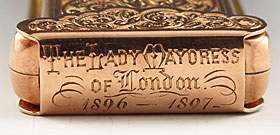
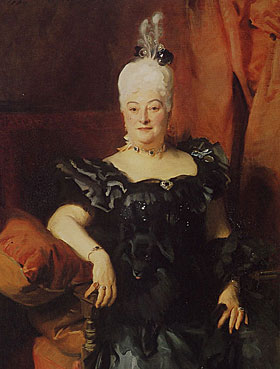
Left: Figure 5. Engraving showing name of needle case. Right: Figure 5a. Painting of Helen Faudel-Phillips.
What makes this needle case unique is the beautifully engraved exterior (Fig. 6). Most Avery style needle cases have the design stamped onto the metal which limits the degree of complexity. With engraving, a much more intricate design can be placed on a piece of metal such as detailed scenes, scrollwork or geometric patterns. To date only four Avery needle cases have been discovered with elaborate engraving like that found on The Lady Mayoress of London. All four of these were Quadruples created by two companies in Birmingham, UK, both jewelers: two by G. H. Johnstone and Co. and two by G. C. Haseler & Co. (aka George Carter Haseler). The back of Johnstone’s The Lady Mayoress of London has an elegant scroll pattern whereas the front contains a shield with the Faudel-Phillips coat of arms, which includes tiny squirrels, peacocks, and other symbols, surrounded by the same scroll pattern. This needle case has the feel of an elegant piece of Victorian jewelry. And who created this item? The firm G. H. Johnstone & Co. was established in Birmingham in 1869 by George Hope Johnstone (1841-1909) (Fig. 6a) when he was 28 years old. Mr. Johnstone was the son of a dance master who had moved to the Birmingham area from London around 1816. Johnstone was the youngest son and had nine siblings, three of his sisters married three of the brothers of George Carter Haseler, the other jeweler who engraved Quadruple needle cases. Not only was Mr. Johnstone a successful businessman but he served for a number of years as a Justice of the Peace for the county of Staffordshire, a part of the Birmingham area. He took an active interest in the local schools, hospitals and the arts. At one point Mr. Johnstone was a member of the Museum and School Art Committee and served as chairman of the Art Gallery Purchase Committee. He had a strong passion for music as well and was heavily involved with many of the musical institutions and events in the Birmingham area during his lifetime. When his two sons, George Jr. (1868-1952) and Stanley (1873-1936) came of age, they joined their father in the family’s jewelry and goldsmith business, which gave their father even more time to engage in public affairs. George Hope Johnstone’s degree of success was confirmed in 1909 when he died and left an estate valued at £52,879, which is equivalent to approximately £4,133,668 today.

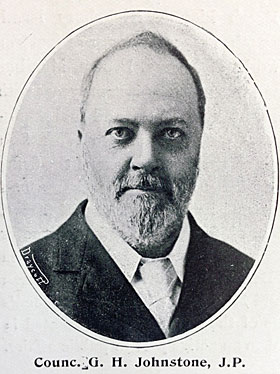
Left: Figure 6. Engraved Exterior. Right: Figure 6a. Photograph of George Hope Johnstone.
Another thing that makes The Lady Mayoress of London needle case so special is the presentation box within which it resides (Fig. 7). This 2.5 by 4 inch container is covered on the outside with a beautiful dark purple velvet with two flaps that open in the center with an elaborate clasp. Once opened, you can see the interior of the flaps covered with white silk while the base of the box contains a platform, with a perfect indentation in which the needle case fits, also covered with the same dark purple velvet fabric. It is obvious The Lady Mayoress of London needle case, in its elaborate container, was most likely commissioned by a family friend or colleague of the mayor of London. It was a gift for his wife when Sir George Faudel-Phillips served as mayor in 1897. G. H. Johnstone & Co. was presumably selected to create it because of their reputation as excellent goldsmiths and jewelers.
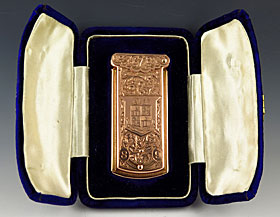
Left: Figure 7.The needle case in its presentation box.
For more information about Avery needle cases, be sure and visit my website entitled “The Avery Needle Case Resource Center” at www.coulthart.com/avery. Feel free to contact me at meinket@yahoo.com if you have information about Avery needle cases that you’d like to share with me.
Sources:
- US Patent No. 98904 dated January 18,1870
- Photographs of The Lady Mayoress of London needle case by Terry Meinke
- Avery background – from A Guide to Collecting Avery Needle Cases - Second Edition by Terry Meinke published in 2020
- Hallmark background - from https://www.gold-traders.co.uk/hallmarks/
- Helen Faudel-Phillips painting - by John Singer Sargent 1898 at https://www.pubhist.com/w23137
- Faudel-Phililps biography - from https://en.wikipedia.org/wiki/Faudel-Phillips_baronets
- G. H. Johnstone & Co. makers mark - from an internet search done in 2019
- George Hope Johnstone photograph and biography from https://theironroom.wordpress.com/2019/09/23/george-hope-johnstone-and-the-headingley-birthday-book/ and research currently being done by Terry Meinke for her next book about the 19 companies from Birmingham associated with Avery needle cases will probably be published in 2021 or 2022
- Money conversion from 1910-2017 - The National Archives, Kew website at http://www.nationalarchives.gov.uk/currency-converter/




